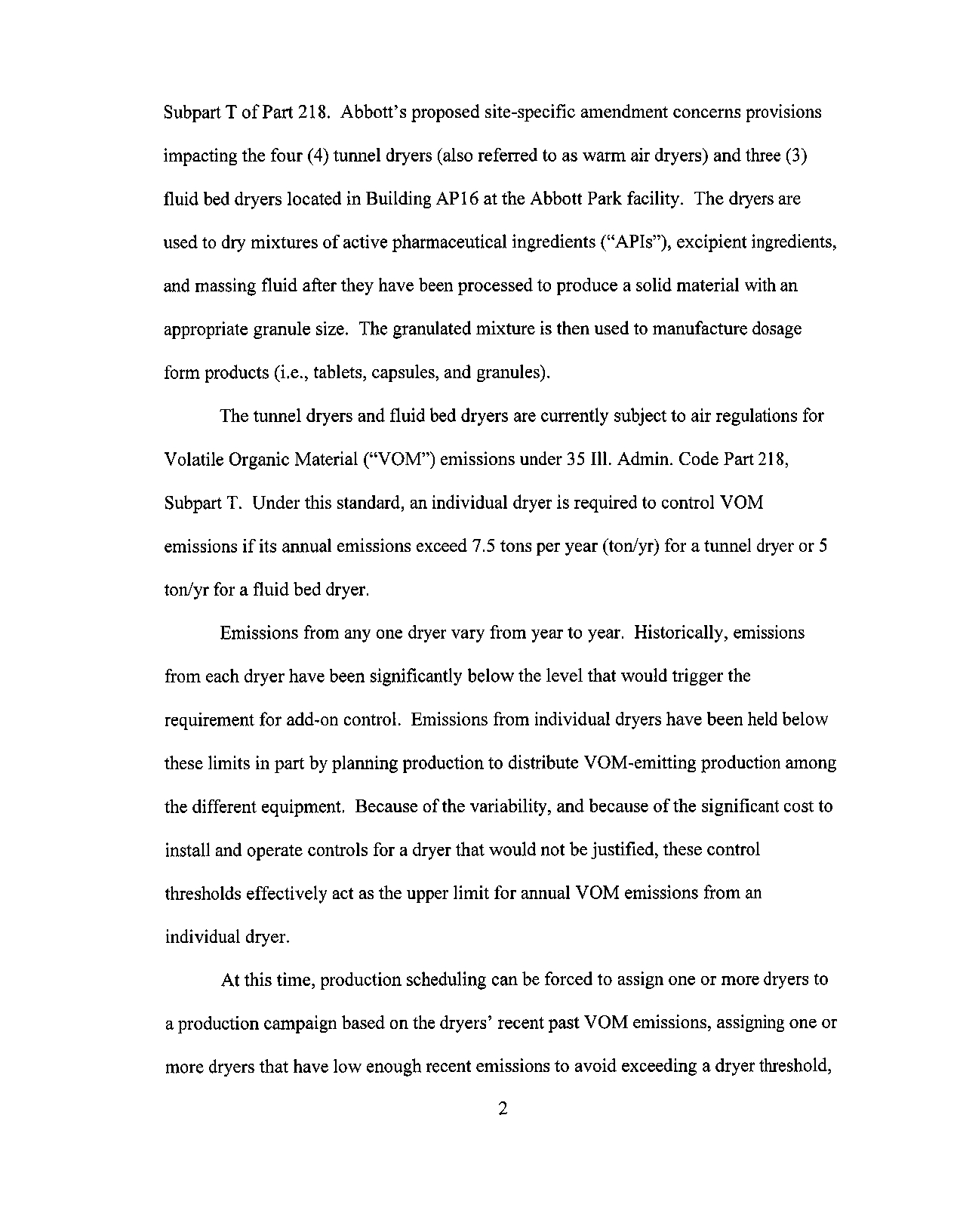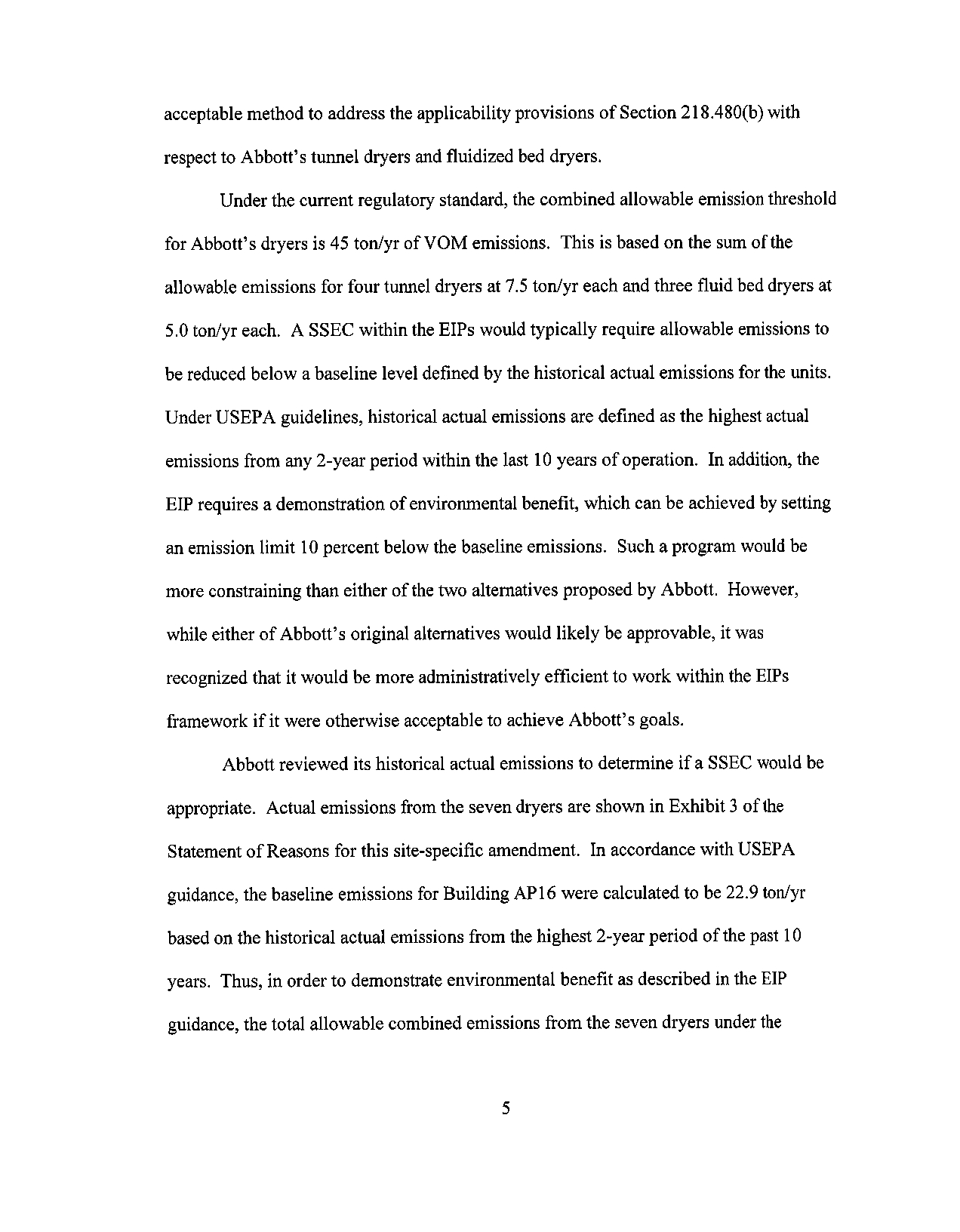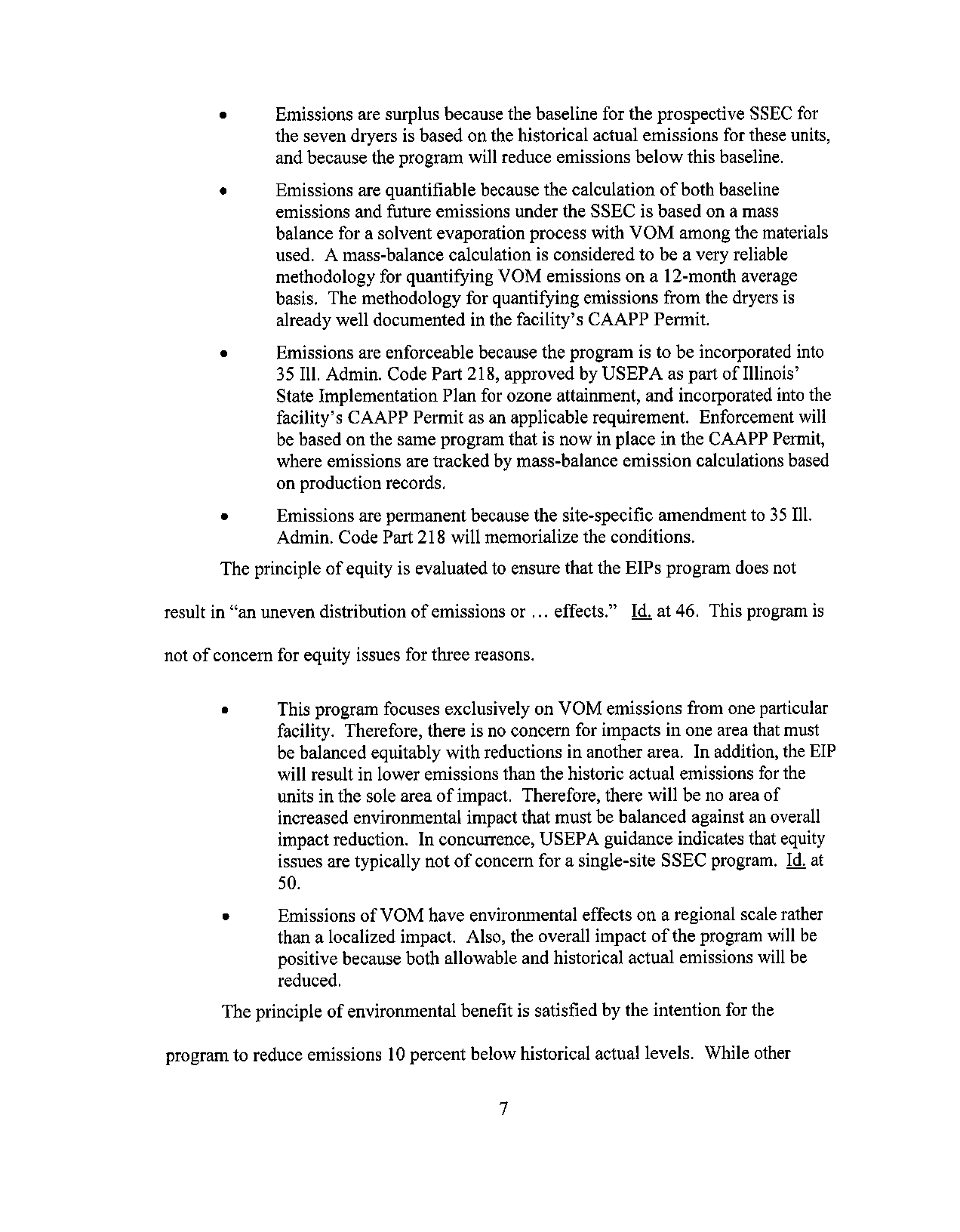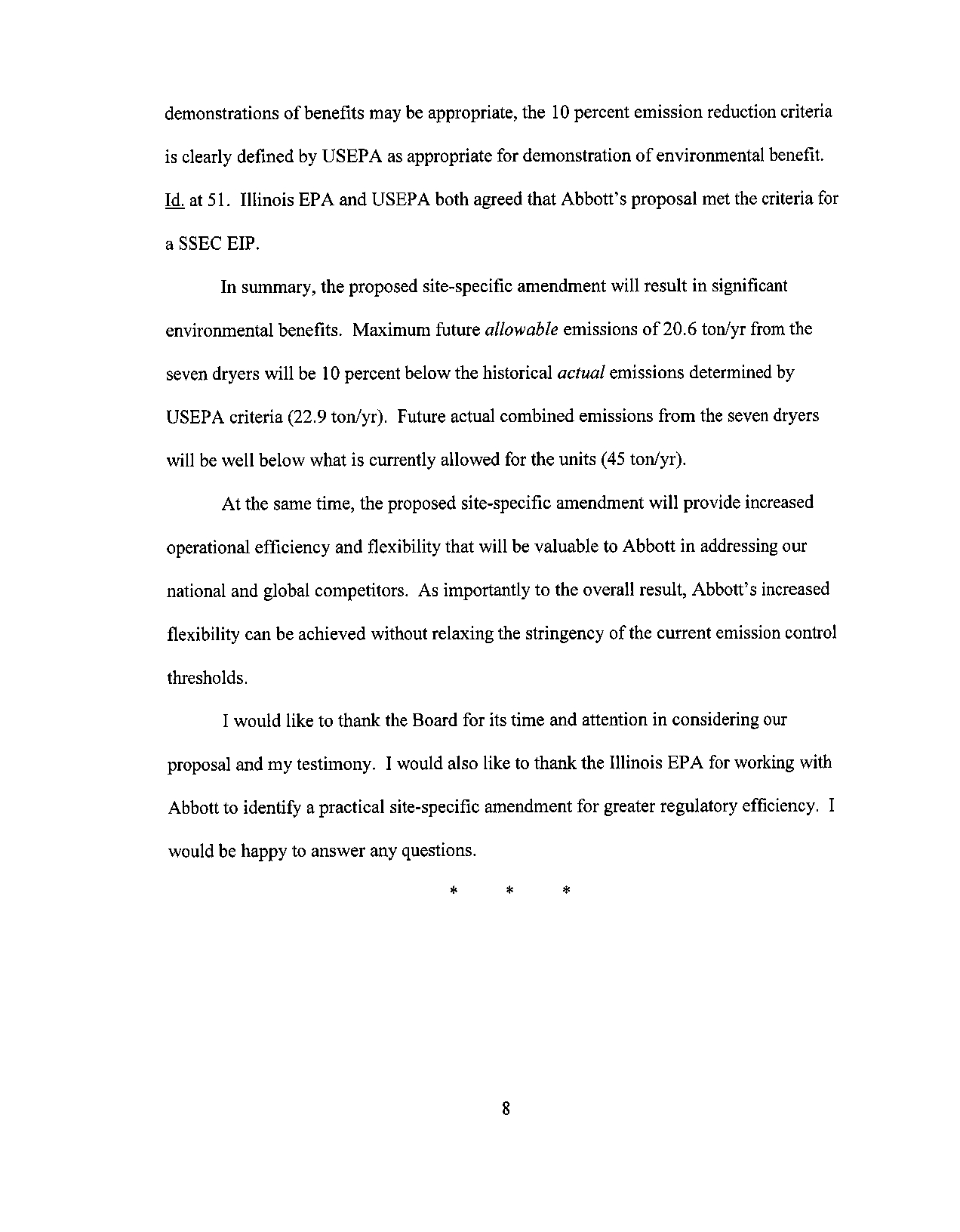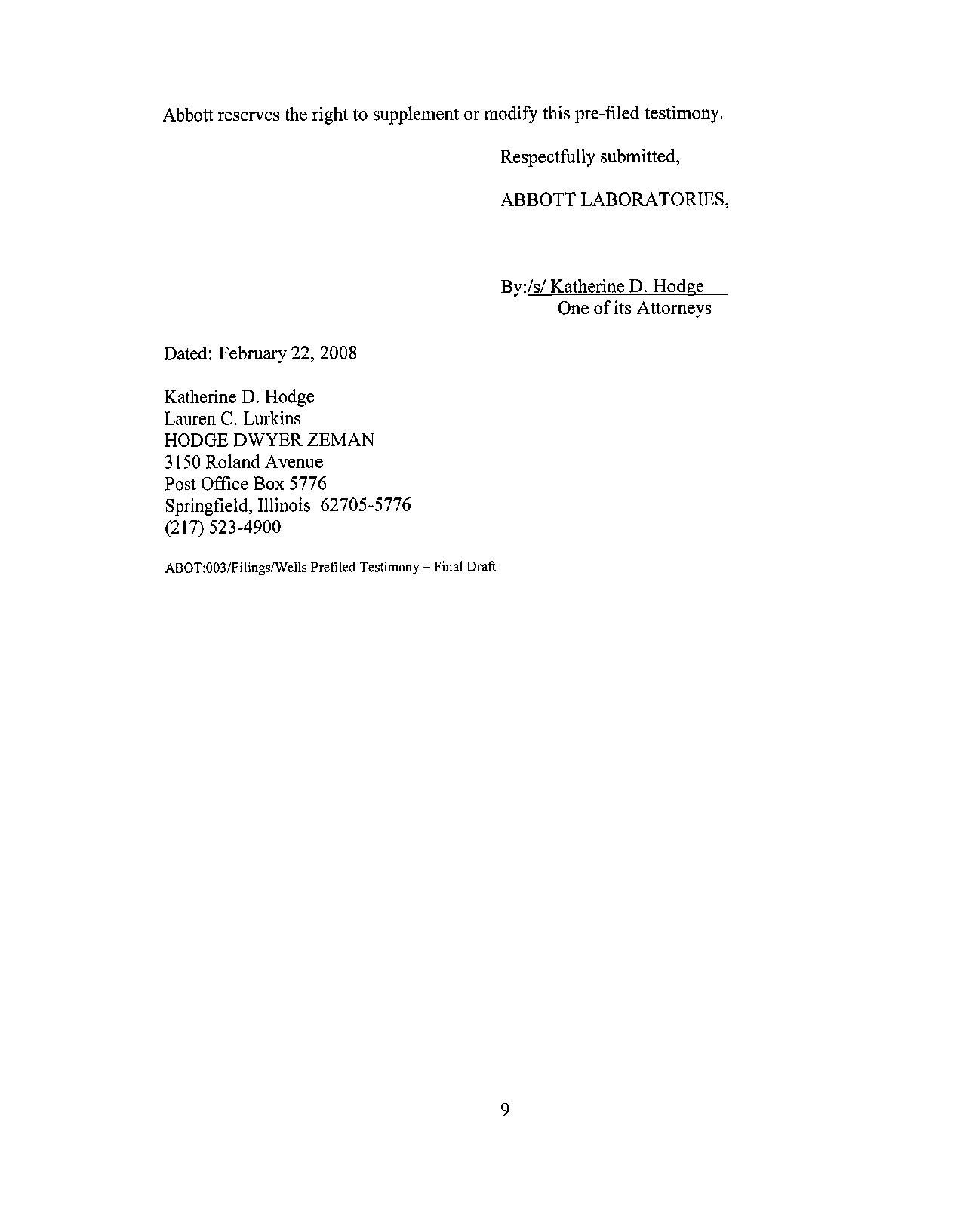BEFORE THE ILLINOIS POLLUTION CONTROL BOARD
IN THE MATTER OF:
)
ABBOTT LABORATORIES' PROPOSED )
SITE-SPECIFIC AMENDMENT TO
)
APPLICABILITY SECTION OF ORGANIC )
MATERIAL EMISSION STANDARDS AND)
LIMITATIONS FOR THE CHICAGO AREA;)
SUBPART T: PHARMACEUTICAL
)
MANUFACTURING (35 ILL. ADM. CODE )
218.480(b))
)
R08-8
(Rulemaking -Air)
N
OTICE
OF FILING
TO: M r. John Therriault
Assistant Clerk of the Board
Illinois Pollution Control Board
100 West Randolph Street
Suite 11-500
Chicago, Illinois 60601
(VIA ELECTRONIC MAIL)
Kathleen M. Crowley
Hearing Officer
Illinois Pollution Control Board
100 West Randolph Street
Suite 11-500
Chicago, Illinois 60601
(VIA U.S. MAIL)
(PERSONS ON
ATTACHED SERVICE LIST)
P LEASE TAKE NOTICE that I have today filed with the Office of the Clerk of
the Illinois Pollution Control Board ENTRY OF APPEARANCE OF LAUREN
C.
LURKINS, PREFILED TESTIMONY OF DIANE BENO IN SUPPORT OF
PROPOSED SITE-SPECIFIC
AMENDMENT, and PREFILED TESTIMONY OF
ROBERT C. WELLS
IN SUPPORT OF PROPOSED SITE-SPECIFIC
AMENDMENT, copies of which are herewith served upon you.
Respectfully submitted,
Dated: February 22, 2008
K atherine D. Hodge
Lauren C. Lurkins
HODGE DWYER ZEMAN
3150 Roland Avenue
P ost Office Box 5776
Springfield, Illinois 62705-5776
(217) 523-4900
By: /s/ Katherine D. Hodue
Katherine D. Hodge
Electronic Filing - Received, Clerk's Office, February 22, 2008
CERTIFICATE
OF SERVICE
I, Katherine D. Hodge, the undersigned, hereby certify that I have served the
ENTRY OF APPEARANCE
OF LAUREN C. LURKINS, PREFILED TESTIMONY OF
DIANE
BENO IN SUPPORT OF PROPOSED SITE-SPECIFIC AMENDMENT, and
PREFILED TESTIMONY OF ROBERT
C. WELLS IN SUPPORT OF PROPOSED
SITE-SPECIFIC AMENDMENT upon:
M r. John Therriault
Assistant Clerk of the Board
Illinois Pollution Control Board
100 West Randolph Street
Suite 11-500
Chicago, Illinois 60601
v ia electronic mail on February 22, 2008; and upon:
Kathleen M. Crowley
Hearing Officer
Illinois Pollution Control Board
James R. Thompson Center
100 West Randolph Street, Suite 11-500
Chicago,
Illinois
60601
Matthew J. Dunn, Chief
Environmental Bureau North
Office of the Attorney General
6 9 West Washington Street, Suite 1800
Chicago, Illinois 60602
Charles E. Matoesian, Esq.
Assistant Counsel
Division of Legal Counsel
Illinois Environmental Protection Agency
1021 North
Grand
Avenue East
Post Office Box 19276
Springfield, Illinois 62794-9276
Office of Legal Services
Illinois Department
of Natural Resources
One Natural Resources
Way
Springfield, Illinois 62702-1271
b y depositing said document in the United States Mail, postage prepaid, in Springfield,
Illinois on February 22, 2008.
/s/ Katherine D. Hodee
Katherine D. Hodge
A BOT:003/FilingsMOF, Profiled Testimony
Electronic Filing - Received, Clerk's Office, February 22, 2008
BEFORE THE ILLINOIS POLLUTION CONTROL BOARD
IN THE MATTER OF:
)
ABBOTT LABORATORIES' PROPOSED )
R08-8
SITE-SPECIFIC AMENDMENT TO
) (Rulemaking
-Air)
APPLICABILITY SECTION
OF ORGANIC )
MATERIAL EMISSION
STANDARDS
AND)
LIMITATIONS
FOR THE CHICAGO AREA;)
SUBPART
T: PHARMACEUTICAL
)
MANUFACTURING (35 ILL. ADM. CODE )
218.480(6))
)
ENTRY OF APPEARANCE OF LAUREN C. LURKINS
NOW COMES Lauren C. Lurkins, of the law firm HODGE DWYER ZEMAN,
and hereby enters her appearance in this matter on behalf
of Abbott Laboratories.
Respectfully submitted,
By:
D ated: February 22, 2008
Lauren C. Lurkins
HODGEDWYERZEMAN
3150
Roland Avenue
Post Office Box 5776
Springfield, Illinois
62705-5776
(217) 523-4900
A BOTa03/Fil/EOA-LCL
Electronic Filing - Received, Clerk's Office, February 22, 2008
BEFORE THE
ILLINOIS POLLUTION CONTROL BOARD
IN THE MATTER OF:
)
ABBOTT LABORATORIES' PROPOSED )
R08-8
SITE-SPECIFIC AMENDMENT
TO
) (Rulemaking-Air)
APPLICABILITY SECTION OF
ORGANIC )
MATERIAL EMISSION STANDARDS
AND)
LIMITATIONS FOR THE CHICAGO AREA;)
SUBPART T: PHARMACEUTICAL
)
MANUFACTURING (35 ILL. ADM. CODE )
218.480(6))
)
PRE-FILED TESTIMONY OF DIANE
BEND,
IN SUPPORT OF PROPOSED SITE-SPECIFIC
AMENDMENT
N OW
COMES ABBOTT LABORATORIES, by and through its attorneys,
HODGE DWYER ZEMAN, and pursuant to 35 III. Admin. Code §
102.424 and the
Hearing
Officer Order, dated January 31, 2008, submits the following Pre-Filed
Testimony of Diane Beno for presentation
at the March 7, 2008 hearing scheduled in the
above-referenced matter:
TESTIMONY OF DIANE BENO
My name is Diane Beno. I am the plant manager of the portion
of the Abbott
Laboratories facility internally known as Building APl6. The operations contained in
Building AP 16 produce intermediate and final pharmaceutical product
formulations,
including liquids, tablets and capsules packaged in bottles and blister formats. The
general
process flow involves: receipt of raw materials; weighing of ingredients; massing
and granulation of ingredients; compressing granulated product into tablets; coating
tablets or particles; printing symbols
onto tablets; and packaging finished products for
distribution.
Electronic Filing - Received, Clerk's Office, February 22, 2008
Over the
course of a year, we produce many different products in Building AP 16.
For example, we produce pharmaceuticals that treat diseases in the field of neuroscience
such as epilepsy and bipolar disorder, we make antiviral products for the treatment of
AIDS, we manufacture antibiotics to fight infection, we package products that help
patients achieve healthy cholesterol levels, and products that improve the lives of people
with rheumatoid arthritis, psoriasis and Crohn's disease.
We manufacture our products using batch production processes. In batch
production, all of the processing equipment in a process
train, including
the dryers,
manufactures one product
at a time. Each batch is completed before the manufacture of
the next batch begins. In a typical process, the active and inactive ingredients
are
combined with a liquid in a process
called "massing." This massing process forms
uniform granules.
The wet granules are dried in tunnel dryers or fluid bed dryers and
then further processed into tablets or capsules.
The
massing fluid, which is typically either water or ethanol, is evaporated from
the solid material in the drying step. If an organic solvent is
volatilized
from the dryer,
it
is emitted to the ambient air as
volatile organic material ("VOM") or volatile organic
compounds ("VOCs"). The quantity of VOM emissions will
vary
for different
products,
and is calculated from the quantity of VOM added
to the mixture and loss factors defined
for the dryers and specified
in
the
Clean Air Act Permitting Program ("CAAPP") Permit
for the facility. It is also important to note
that the organic solvent currently used in
granulation and dried
from the granulated mixtures at Building AP16 is ethanol. Ethanol
is a VOM, but is not considered a hazardous air pollutant ("HAP"),
The proposed site-
specific amendment will have no
effect on HAP emissions.
2
Electronic Filing - Received, Clerk's Office, February 22, 2008
Abbott's proposed site-specific amendment for
Building
AP
16 covers four tunnel
dryers and three fluid bed dryers. One
additional fluid bed dryer, located in Building
AP16, is used exclusively
for research and development operations and is not involved
in
the normal operating processes
in Building APl6. Therefore, our proposed amendment
does not include
that dryer.
The tunnel dryers and fluid bed dryers operate on different principles.
In the use
of tunnel dryers, materials
to be dried are spread on trays and placed in a warming
chamber or "tunnel"
that circulates warm air over and under the trays.
A fluid bed dryer is a large vertical cylindrical shaped
vessel with a diffuser that
blows
warm air up from the bottom of the vessel. The wet intermediate granules are
loaded into the dryer and flow upward, suspended
in the warm air stream. Abbott has
increased its use of fluid bed dryers
for recently developed products because they are
more efficient and
produce a more uniform product than the tunnel dryers. Abbott
anticipates increased use of water
for
the
massing fluid in future products. Abbott
expects that this preferential
use of fluid bed dryers and water-based products will
continue. That
is, many new products are expected to use fluid bed
dryers and water-
based formulations, while
older products will continue to be manufactured using
tunnel
dryers.
Batches of specific products are typically
manufactured using either one or more
tunnel
dryers, or one or more fluid bed dryers, but not both, because the technologies
are
not interchangeable. Individual dryers
of the same type can typically be used in
combination or interchangeably
in many cases, but specific dryers are preferable
for
Electronic Filing - Received, Clerk's Office, February 22, 2008
combining with other equipment in a process train to manufacture certain products from
an operational efficiency standpoint.
Abbott manufactures its products using
batch processes whereby each
manufacturing process train and its associated equipment (including the dryers) produces
one product at a time in fixed batch sizes. Process
trains are designed to accommodate
batches of different scales,
with some for large batches and others for small batches.
Therefore, the scale of a given batch
plays an important role in determining which of the
dryers will be most
efficient. Additionally, in accordance with United States Food and
Drug
Administration
("US FDA") current Good Manufacturing Practice ("cGMP")
guidelines, extensive equipment
cleaning is required between batches of different
products, resulting
in up to three days of lost production time. Therefore, Abbott uses a
campaign strategy to continue running batches of the same product consecutively
in the
process train to minimize this cleaning time.
As currently written, Section 218.480(b) effectively
defines a 12-month total
VOM limit on each individual dryer.
This can limit Abbott's ability to schedule the
campaigns of
certain products to maximize the efficiency of the processes. In other
words, to ensure compliance
with
the
current running 12-month total VOM limit on each
dryer, for a particular batch,
Abbott may be required to utilize a dryer with low VOM
emissions during
the last 12 months instead of using the dryer that is the
most efficient
from a production-scale standpoint.
Such selection of dryers, based only on the amount
of VOM that
has been emitted from an individual dryer during
the preceding 12 months,
is an inefficient approach to scheduling
the use of Abbott's equipment and resources.
Additionally, the dryer
selected for a given campaign also depends
on dryer availability
4
Electronic Filing - Received, Clerk's Office, February 22, 2008
and other
factors. For example, one dryer may be temporarily out of use to allow for
cleaning or for unscheduled maintenance requirements. Therefore, the standards, as
currently defined, can result in wasted resources by requiring Abbott to dry a small
batch
of product in our large-scale process train to maintain our equipment-specific VOM
limits.
Total annual emissions
from a dryer result from the quantity of organic solvent
removed from the different products processed in a dryer over a rolling 12-month period.
The material is processed in a number of individual campaigns
for particular products,
each consisting of multiple
individual batches. The assignment of a campaign of a
particular product to one or more dryers
involves a number of operating factors, such as
scale and equipment
availability, that contribute to the efficiency of manufacturing. The
VOM emission threshold effectively acts as an overriding factor that can force a
particular production campaign with VOM emissions to be scheduled
using equipment
that has low enough recent emissions to avoid exceeding a dryer threshold, but that may
not otherwise be the optimal or most efficient equipment for the
campaign. This
scheduling shift increases the operational
cost, but results in no environmental benefit,
because the actual emissions will be the same as if the
campaign would have used the
optimal equipment.
In order to
ensure Abbott's Lake County manufacturing facilities remain
competitive with our national
and global competitors, Abbott must continually seek ways
of making
our manufacturing operations more efficient. The scheduling
inefficiency
created by Subpart T was identified as one area
where improvements in efficiency could
be made and is the basis for the proposed
amendment. This seems particularly
5
Electronic Filing - Received, Clerk's Office, February 22, 2008
appropriate, as the business
cost created
by this
inefficiency results in
no environmental
benefit.
The most efficient method to manufacture Abbott's products in Building AP 16
would be to use the dryer that is best suited to the requirements of the production
schedule and scale, regardless of the amount of VOM that has been emitted from that
dryer in the past 12 months. Provided that the combined VOM emissions from all of the
dryers are less than the combined amount allowed under Section 218.480(b), this method
of operation would not require an increase in allowable VOM emissions from the
Facility. In fact, the proposed
amendment would provide Abbott improved production
flexibility to utilize the most efficient dryers for a given product, while significantly
lowering the total allowed
YOM emissions from all the dryers combined.
Thank you. I'll be happy to answer any questions.
Abbott reserves the right to supplement or modify this pre-filed testimony.
Respectfully submitted,
Dated: February 22, 2008
Katherine D.
Hodge
Lauren C. Lurkins
HODGE DWYER ZEMAN
3150 Roland Avenue
Post Office
Box
5776
Springfield,
Illinois 62705-5776
(217) 523-4900
ABBOTT LABORATORIES,
B y:/s/ Katherine D. Hodge
One of its Attorneys
A BOT:003/Filings/Beno Prefiled Testimony -Final Draft
6
Electronic Filing - Received, Clerk's Office, February 22, 2008
BEFORE THE ILLINOIS POLLUTION CONTROL BOARD
IN THE MATTER OF:
)
ABBOTT LABORATORIES' PROPOSED )
R08-8
SITE-SPECIFIC AMENDMENT TO
) (Rulemaking -Air)
APPLICABILITY SECTION
OF ORGANIC )
M ATERIAL EMISSION STANDARDS
AND)
LIMITATIONS FOR THE CHICAGO AREA;)
SUBPART T: PHARMACEUTICAL
)
MANUFACTURING (35 ILL. ADM. CODE )
218.480(b))
)
P RE-FILED TESTIMONY
OF ROBERT C. WELLS,
IN SUPPORT OF PROPOSED SITE-SPECIFIC
AMENDMENT
NOW COMES ABBOTT LABORATORIES, by and through its attorneys,
H ODGE DWYER ZEMAN,
and pursuant to 35 Ill. Admin. Code § 102.424 and the
Hearing Officer Order, dated January 31, 2008, submits the following Pre-Filed
Testimony
of Robert C. Wells for presentation at the March 7, 2008 hearing scheduled in
the above-referenced matter:
TESTIMONY OF ROBERT C. WELLS
My name is Robert C. Wells. I am employed
by
Abbott
Laboratories as Air
Manager for Environmental Support in Abbott's Global Environmental Health and Safety
Department. I provide assistance to Abbott facilities such as Building AP16 with regard
to environmental compliance and managing environmental performance at our facilities
under various air regulations. I have twenty-nine years of experience in air quality
management and the analysis of
air emissions, emission control and ambient air quality.
I hold a Bachelor of Science degree in Engineering from Comell University.
My testimony
today concerns
technical aspects of Abbott's proposal for a site-
specific amendment to Illinois air regulations at 35 Ill. Admin. Code Part 218.480(b), in
Electronic Filing - Received, Clerk's Office, February 22, 2008
Subpart T of Part 218. Abbott's proposed site-specific amendment concerns provisions
impacting the four (4) tunnel dryers (also referred to as
warm
air dryers) and three (3)
fluid bed dryers located in
Building AP16 at the Abbott Park facility. The dryers are
used to dry mixtures of active pharmaceutical
ingredients ("APIs"),
excipient ingredients,
and massing
fluid after they have been processed to produce a solid material with an
appropriate granule size. The granulated mixture is then used to manufacture dosage
form products (i.e., tablets, capsules, and granules).
The tunnel dryers and fluid bed dryers are currently subject to air regulations for
Volatile Organic Material ("VOM") emissions under 35 111. Admin. Code Part 218,
Subpart T. Under this standard, an individual dryer is required to control VOM
emissions if its annual emissions exceed 7.5 tons per year (ton/yr) for a tunnel dryer or 5
ton/yr for a fluid bed dryer.
Emissions
from any one dryer vary from year to year. Historically, emissions
from each dryer have been significantly below
the level that would trigger the
requirement for
add-on control. Emissions from individual dryers have been held below
these limits in part by planning production to distribute VOM-emitting production among
the different equipment. Because of the variability, and because of the significant cost to
install and operate
controls for a dryer that would not be justified, these control
thresholds effectively act as the upper limit for annual VOM emissions from an
individual dryer.
At this time, production scheduling can be
forced to assign one or more dryers to
a production campaign
based on the dryers' recent past VOM emissions, assigning one or
more dryers
that have low enough recent emissions to avoid exceeding a dryer threshold,
2
Electronic Filing - Received, Clerk's Office, February 22, 2008
but that may not otherwise be the optimal or most efficient equipment for the campaign.
This scheduling shift increases the operational cost, but
results
in no
environmental
benefit, because the actual emissions
will be the same as if the campaign would have
used the optimal equipment. This scheduling inefficiency was identified as one area
where improvements in efficiency could be
made, while not increasing the environmental
impact of Abbott's operations.
Two environmental management approaches were identified and considered in
order to alleviate
the inefficiency of the Subpart T operating constraints. One alternative
would be to increase the threshold that would trigger the emission control requirement for
one or more individual dryers. Such an increase would be justified if the cost of control
is greater than what is considered economically achievable for Reasonably Available
Control Technology ("RACT"), which was the justification for establishing the original
thresholds in Subpart T. A preliminary review of
emission control costs indicated that
RACT controls would not be justified even at emission thresholds significantly higher
than the current limits specified in Subpart
T. A second alternative would be to treat the
current control threshold
as a combined threshold equal to the sum of the individual unit
thresholds for the seven manufacturing dryers. This approach would remove
a
manufacturing
constraint without increasing the allowable VOM emissions from the
facility.
The above alternatives were first evaluated intemally
within Abbott. Under the
first approach, while Abbott believes that it would be justifiable to increase
the emission
threshold for one or more dryers, it would also
act to increase the facility's allowable
emissions, which
is not necessary to solve problems of manufacturing efficiency.
The
3
Electronic Filing - Received, Clerk's Office, February 22, 2008
second approach,
to re-define the emission threshold as a combined threshold for all
dryers, would remedy manufacturing inefficiencies without increasing overall
allowable
VOM emissions.
Both of these approaches were discussed
with the Illinois Environmental
Protection Agency ("Illinois EPA").
At that time, Illinois EPA indicated that both
Illinois EPA policy and United
States Environmental Protection Agency ("USEPA")
regulations and guidelines would need to be considered in order for the agency to support
a site-specific amendment to 35
Ill. Admin. Code Part 218.
Subsequent
discussions among Illinois EPA, USEPA, and Abbott's
representatives identified an existing USEPA program that
would
provide
similar
operational benefits
as the combined threshold approach discussed above. USEPA's
Economic Incentive Programs ("EIPs") are described
in
USEPA's
document, Improving
Air Quality With Economic Incentive
Programs, EPA-452/R-01-001, January 2001,
which was provided as Exhibit 2 to the Statement of
Reasons for the proposed site-
specific amendment. Among other programs,
this guidance includes provisions for a
Source-Specific Emission Cap
("SSEC") as an alternative regulatory approach for
emission limits that can regulate emissions with greater flexibility
and efficiency than
conventional approaches.
Discussions
with Illinois EPA and USEPA indicated
that a SSEC could allow
individual emission limits to be combined
into an aggregate cap for the tunnel dryers and
fluid bed
dryers, provided that the SSEC is set to a
level which is less than the units'
combined historical actual emissions,
rather than equal to current combined allowable
emissions. Both Illinois
EPA and USEPA indicated that a SSEC EIP
would be an
4
Electronic Filing - Received, Clerk's Office, February 22, 2008
acceptable method to address the applicability provisions
of Section 218.480(b) with
respect to Abbott's tunnel dryers and
fluidized bed dryers.
Under the
current regulatory standard, the combined allowable emission
threshold
for Abbott's dryers is 45 ton/yr
of VOM emissions. This is based on the sum of the
allowable
emissions for four tunnel dryers at 7.5 ton/yr each and three
fluid bed dryers at
5.0 ton/yr each. A SSEC within the EIPs would typically
require allowable emissions to
be reduced below
a baseline level defined by the historical actual emissions for the units.
Under USEPA guidelines, historical actual emissions are defined
as the highest actual
emissions from any 2-year period within the last
10 years of operation. In addition, the
EIP requires a demonstration of
environmental benefit, which can be achieved by setting
an emission limit 10 percent below the baseline
emissions. Such a program would be
more constraining than
either of the two alternatives proposed by Abbott. However,
while
either
of Abbott's original alternatives would likely be
approvable, it was
recognized that it would
be more administratively efficient to work within the
EIPs
framework
if it were otherwise acceptable to achieve Abbott's
goals.
Abbott reviewed its historical actual emissions
to determine if a SSEC would be
appropriate.
Actual emissions from the seven dryers are shown in Exhibit 3 of the
Statement of Reasons for this site-specific amendment.
In accordance with USEPA
guidance, the baseline emissions
for Building AP 16 were calculated to be
22.9 ton/yr
based on the
historical actual emissions from the highest
2-year period of the past 10
years. Thus, in order
to demonstrate environmental benefit
as described in the EIP
guidance, the total allowable combined emissions
from the seven dryers under the
Electronic Filing - Received, Clerk's Office, February 22, 2008
proposed SSEC
would need to be set at a level 10 percent lower than the calculated
baseline
emissions, or 20.6 ton/yr of V OM.
In comparison with this prospective limit,
the current combined allowable VOM
emission rate,
based on the individual thresholds for each of the seven dryers,
is 45
ton/yr. Although Abbott could operate at this emission
level if needed for operations, its
historical actual emissions have
consistently been lower than the current combined
allowable emissions for the seven dryers.
Thus, the current allowable combined emission
rate is higher than what Abbott
is proposing under the amended site-specific standard.
Abbott considers the
flexibility to shift production among the dryers to be more
important
than the ability to operate with current maximum overall emissions. Therefore,
the
principal requirement for
a SSEC under the EIP, a combined allowable emission
threshold
lower than historical actual emissions, would be an acceptable
alternative to
Abbott.
In order to ensure that the proposed site-specific
amendment to 35 Ill. Admin.
Code § 218.480(b) is consistent with USEPA
guidance regarding EIPs, and to realize the
administrative benefit of
a program that is acceptable to all prospective parties,
the
program must satisfy three fundamental
principles of USEPA's EIP program: integrity,
equity and environmental
benefit. These are defined and discussed in USEPA's
Improving Air Quality
with Economic Incentive Program. See
Exhibit 2, Statement of
Reasons. Consistency with each of these three principles
is discussed separately below.
The principle
of integrity consists of four elements:
emissions must be surplus,
quantifiable, enforceable, and permanent.
Note that these terms have specific
meanings,
and are different for a SSEC
than for other programs addressed
by the policy. Id. at 35.
6
Electronic Filing - Received, Clerk's Office, February 22, 2008
Emissions
are surplus because the baseline for the prospective SSEC for
the seven dryers is based on the historical actual emissions for these units,
and because the program will reduce emissions below this baseline.
Emissions are quantifiable because the
calculation of both baseline
emissions and
future emissions under the SSEC is based on a mass
balance
for a solvent evaporation process with VOM among the materials
used. A mass-balance calculation is considered to be a very reliable
methodology for quantifying VOM emissions on a 12-month average
basis.
The methodology for quantifying emissions from the dryers is
already well documented in the facility's CAAPP Permit.
Emissions
are enforceable because the program is to be incorporated into
35 Ill. Admin. Code Part
218, approved by USEPA as part of Illinois'
State Implementation
Plan for ozone attainment, and incorporated into the
facility's
CAAPP Permit as an applicable requirement. Enforcement will
be
based on the same program that is now in place in the CAAPP Permit,
where emissions are tracked by mass-balance emission calculations based
on production records.
Emissions are permanent because the site-specific amendment
to 35 Ill.
Admin. Code Part 218 will memorialize
the conditions.
The principle
of equity is evaluated to ensure that the EIPs program does not
result in "an uneven distribution of emissions or ... effects."
Id. at 46. This program is
not of concern for equity issues
for three reasons.
This program focuses exclusively on VOM emissions
from one particular
facility. Therefore, there is no concern
for impacts in one area that must
be balanced equitably with reductions in another area. In addition, the
EIP
will result in lower emissions than the historic actual emissions
for the
units in the sole area of impact. Therefore, there
will
be
no area of
increased environmental impact that must be
balanced against an overall
impact reduction. In concurrence, USEPA
guidance indicates that equity
issues are typically not of concern
for a single-site SSEC program. Id. at
50.
Emissions of VOM have environmental effects on a regional
scale rather
than a localized impact. Also, the
overall impact of the program will be
positive because both allowable and historical actual emissions will be
reduced.
The principle of environmental benefit is satisfied
by the intention for the
p rogram to reduce
emissions 10 percent below historical actual
levels. While other
7
Electronic Filing - Received, Clerk's Office, February 22, 2008
demonstrations of benefits may
be appropriate, the 10 percent emission reduction criteria
is clearly defined
by USEPA as appropriate for demonstration of environmental
benefit.
Id. at 51. Illinois EPA and USEPA both agreed that Abbott's proposal
met the criteria for
a SSEC EIP.
In summary, the proposed site-specific amendment will result
in significant
enviromnental benefits. Maximum future allowable
emissions of 20.6 ton/yr from the
seven
dryers will be 10 percent below the historical actual emissions determined by
USEPA criteria (22.9 ton/yr). Future actual
combined emissions from the seven dryers
will be well below what
is currently allowed for the units (45 ton/yr).
At the same
time, the proposed site-specific amendment will provide increased
operational efficiency and flexibility
that will be valuable to Abbott in addressing our
national and global
competitors. As importantly to the overall result, Abbott's increased
flexibility
can be achieved without relaxing the stringency of the
current emission control
thresholds.
I would like to thank the Board for its time and
attention in considering our
proposal and my testimony. I would also
like to thank the Illinois EPA for working with
Abbott to identify a practical site-specific amendment for greater regulatory
efficiency. I
would be happy to answer any questions.
Electronic Filing - Received, Clerk's Office, February 22, 2008
Abbott reserves the right to supplement
or modify this pre-filed testimony.
Respectfully submitted,
ABBOTT LABORATORIES,
By:/s/ Katherine D. Hodge
One of its Attorneys
Dated: February 22, 2008
K atherine D. Hodge
Lauren C. Lurkins
H ODGE DWYER ZEMAN
3150 Roland Avenue
Post Office Box 5776
Springfield, Illinois 62705-5776
(217) 523-4900
ABOT:003/Filings/Wells Prellled Testimony-Final
Draft
Electronic Filing - Received, Clerk's Office, February 22, 2008











